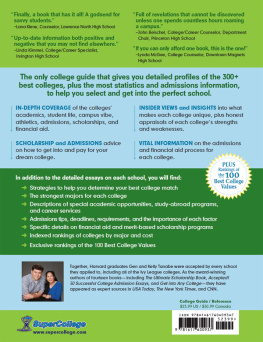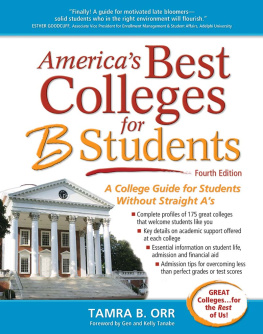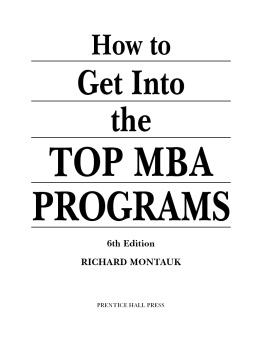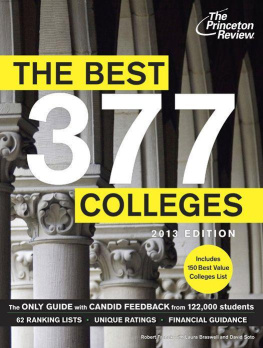Table of Contents
Other books by Richard Montauk
HOW TO GET INTO THE TOP MBA PROGRAMS
HOW TO GET INTO THE TOP LAW SCHOOLS
To my mother, who believed that education could change the world
Richard Montauk
To Mom and Dad, who made sure
I received the best education possible and supported me
every step of the way
Krista Klein
ACKNOWLEDGMENTS
We wish to thank those people who have been so helpful to the development and writing of How to Get Into the Top Colleges.
First, we thank the admissions and financial aid directors at top colleges in the United States and Great Britain, who have been so generous with their time and knowledge in discussing how admissions and financial aid decisions are made at their schools. In particular, we would like to thank those we interviewed for this book and who have allowed themselves to be quoted in the text:
Joe Paul Case, Katie Fretwell (Amherst); Leigh Campbell (Bates); Ken Himmelman, Meg Woolmington (Bennington); Bernard Pekala (Boston College); Walter Moulton, Richard Steele (Bowdoin); Michael Bartini, Michael Goldberger, James Miller (Brown); Nancy Monnich, Jennifer Rickard (Bryn Mawr); Rick Bischoff, David Levy (Cal Tech); Richard Black (UC Berkeley); Simon Goldhill (Kings College, Cambridge); Ray Jobling (St. Johns College, Cambridge); Paul Thiboutot, Leonard Wenc (Carleton); Alicia Reyes (University of Chicago); Parker Beverage, Steve Thomas, Lucia Whittelsey (Colby); Eric Furda (Columbia); Tim Cheney (Connecticut College); Tom Keane (Cornell); Karl Furstenberg, Virginia Hazen, Maria Laskaris (Dartmouth); Chris Gruber, Kathleen Stevenson-McNeely (Davidson); James Belvin, Christoph Guttentag (Duke); Julia Perreault, Dan Walls (Emory); Barbara Bergman, Charles Deacon, Patricia McWade (Georgetown); Ingrid Hayes (Georgia Tech); Marlyn McGrath Lewis (Harvard); Thyra Briggs, Youlanda Copeland-Morgan (Harvey Mudd); David Hoy, Jess Lord, Delsie Phillips (Haverford); Robert Massa (Johns Hopkins); Louse Burton (London School of Economics and Political Science); Marilee Jones, Stuart Schmill (MIT); Pam Fowler, Theodore Spencer (Michigan); Robert Clagett, John Hanson (Middlebury); Jane Brown (Mount Holyoke); Richard Avitabile (NYU); Stephen Farmer (University of North Carolina, Chapel Hill); Rebecca Dixon, Sheppard Shanley (Northwestern); Joseph Russo, Daniel Saracino (Notre Dame); Howard Thomas (Oberlin); Anne Daniel (Christ Church, Oxford); Michael Allingham (Magdalen College, Oxford); Eric Kaplan, Lee Stetson (Penn); Patricia Coye, Bruce Poch (Pomona); Don Betterton, Janet Lavin Rapelye (Princeton); Paul Marthers (Reed); Heather McDonnell, Stephen Schierloh (Sarah Lawrence); Debra Shaver, Myra Smith, Nancy Tessier (Smith); Catherine Thomas (USC); Cynthia Hartley, Richard Shaw (Stanford); James Bock (Swarthmore); Larry Burt, Kedra Ishop (University of Texas, Austin); Lee Coffin (Tufts); Elaine Rivera (Tulane); Rollie Stoneman (U.S. Air Force Academy); Captain Susan Bibeau (U.S. Coast Guard Academy); Captain Robert Johnson (U.S. Merchant Marine Academy); Major William Smith (U.S. Military Academy); Captain Karen Frye (U.S. Naval Academy); Douglas Christiansen, David Mohning, William Shain (Vanderbilt); David Borus (Vassar); John Blackburn, Yvonne Hubbard (University of Virginia); Nanette Tarbouni (Washington University); Jennifer Desjarlais (Wellesley); Nancy Hargrave Meislahn, Barbara-Jan Wilson (Wesleyan); Kim Van Deusen (William & Mary); Dick Nesbitt, Phillip Smith, Philip Wick (Williams); Steve Van Ess (University of Wisconsin, Madison); Margit Dahl, and Donald Routh (Yale).
Second, we thank counselors at leading high schools across the country, who were similarly helpful: Antoinette Alonzo (Hirschi Math-Science IB Magnet High School, Wichita Falls, Texas); Sally Best Bailey (Fountain Valley School, Colorado Springs, Colorado); Peggy Blau (Brooklyn Technology High School, New York); John Boshoven (Community High School, Ann Arbor, and Jewish Academy of Metropolitan Detroit, Detroit, Michigan); Barbara Brown (Newton South High School, Massachusetts); Christine Brownfield (Rio Americano High School, Sacramento, California); Donna Cannon (Simsbury High School, Connecticut); Mark Davis (Upper Arlington High School, Ohio); Marlyne DeLima (Coral Reef Senior High School, Miami, Florida); Michael Denning (Noble and Greenough, Boston, Massachusetts); Claire Dickerson (Clayton High School, Missouri); Nick Faraco (Simsbury High School, Connecticut); Cheryl R. Feldsott (Bethesda-Chevy Chase High School, Maryland); Paula Garza (Simsbury High School, Connecticut); Michael Heeter (Hawken School, Gates Mills, Ohio); Kelly Herrington (University Prep, Seattle, Washington); Thomas Hughart (Wellesley High School, Massachusetts); Colette Johnson (South Texas High School for Health Professions, Mercedes, Texas); Gene Kadish (Hanover High School, New Hampshire); Robert Kostrzeski (Drew School, San Francisco, California); Laura Lamb (Shawnee Mission East High School, Kansas); Alan Loper (Chamblee Charter High School, Georgia); Marsha Lynch (Grosse Pointe South High School, Michigan); Andrew McNeill (The Taft School, Watertown, Connecticut); Marisa Ostroff (Tucson High School, Arizona); Maureen Penley (Denver School for the Arts, Colorado); Anne Perina (Whitefish Bay High School, Wisconsin); Nina Pitkin (Thomas Jefferson High School for Science and Technology, Alexandria, Virginia); Robert Pomer (Darien High School, Connecticut); Lynn Redmond (Shattuck-St. Marys School, Faribault, Minnesota); Jonathan Reider (San Francisco University High School, California); Charlene Rencher (Cranbrook School, Detroit, Michigan); Jenny Rodriguez (Bronx Preparatory Charter School, New York); Barbara Sams (St. Louis Priory School, Missouri); and Susan Thorngren (New Trier High School, Winnetka, Illinois).
Third, we thank our clients, from whom we have learned a great deal.
Fourth, we thank our colleague, Rebecca Hulse, for her indefatigable efforts.
Richard Montauk and Krista Klein
ABOUT DEGREE OF DIFFERENCE
Founded by Richard Montauk in 1991, Degree of Difference is an educational consulting firm that provides quality one-on-one service to individuals submitting applications for college and graduate study in a variety of fields. We help hundreds of individuals each year plan their college and graduate careers and complete successful applications to the top programs worldwide.
Our advice for youa college-bound student set on attending one of the top schoolsis informed not only by the years of service we have provided to successful college applicants, but also by our work with college graduates working on later steps in their educations and careers. Because our collective expertise extends beyond the realm of college, into the areas of graduate study and career advising, our perspective is like that of a wide-angle lens. (For more information on some of our advisory services to those preparing for post-graduate study, see How to Get Into the Top MBA Programs and How to Get Into the Top Law Schools, both by Richard Montauk and also published by Prentice Hall.)
We provide a full menu of services for college applicants and their families:
Matching students with colleges. We begin the consulting process with each client by inquiring into past experiences and ambitions for the future. After learning more about you, your background, your education, and your goals, we help you research colleges and discover what programs and options are available to you. We help you select colleges that are most appropriate for your needs and desires, and also ensure that your final list of target colleges includes an adequate number of stretches, possibles, and likelies.








